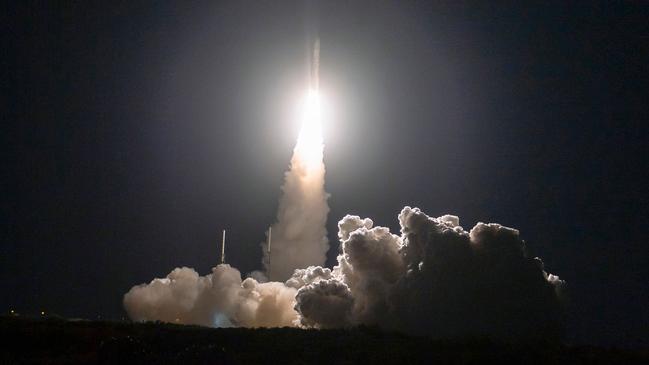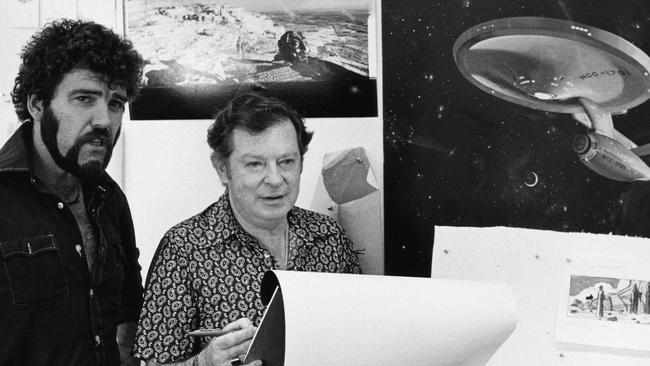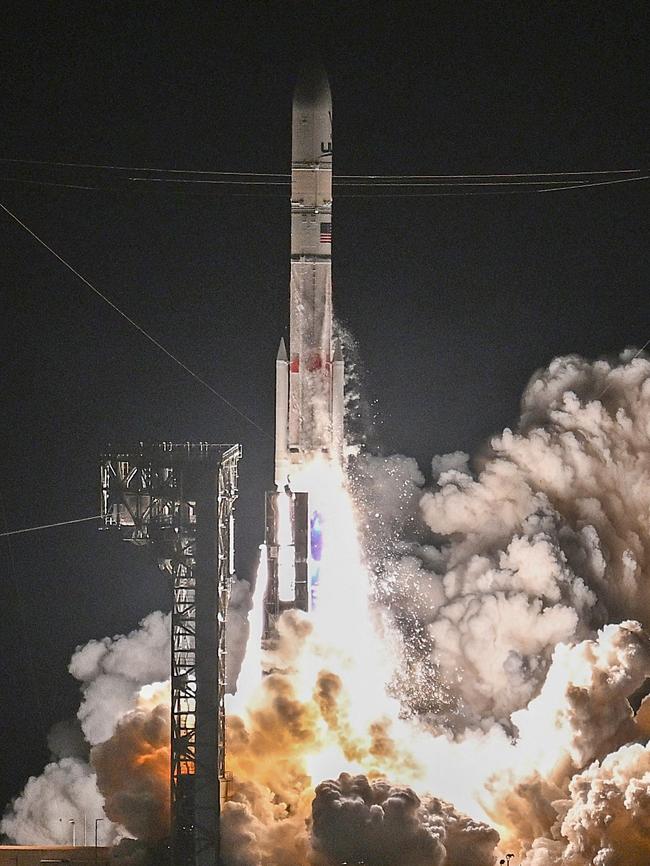Final frontier after death is either space, or the freezer
Funerals have become more complicated, with interstellar and cryogenic options all the rage. Here are all your options – as well as the costs.

Last month, the Peregrine lunar lander crashed back to earth after a propellant leak ended its chances of reaching the moon. The doomed lander could have been left to hurtle into outer space, another piece of junk in an increasingly hazardous galactic scrapyard, but NASA scientists decided the safer option was to let it burn up in the earth’s atmosphere.
There was no shame in failing to land a spacecraft on the moon – only a handful of national space agencies have achieved it: the Soviet Union, the United States, China, India and, a fortnight ago, Japan.
According to NASA’s mission report, the Peregrine lander carried “about 20 payloads of various types”, including an array of scientific instruments designed to measure heat and radiation in the lunar exosphere and to map the moon’s magnetic fields.
Five so-called “science payloads” originally planned for Peregrine were said to have been “reallocated” to future lunar delivery missions, perhaps to accommodate “non-science” payloads that NASA was embarrassed to mention in its mission report.
Among the non-science payloads were cremated remains and DNA belonging to Star Trek creator Gene Roddenberry and Star Trek actors Nichelle Nichols (who played Lieutenant Uhura), DeForest Kelley (Bones), and James Doohan (Scotty). The controversial cargo also included DNA from the science fiction writer Arthur C. Clarke and hair samples from former US presidents Dwight D. Eisenhower, John F. Kennedy and George Washington. Some of the ashes were said to be earmarked for “interment” on the moon’s surface, while the presidential hair was destined to carry on into deep space.

It was not the first time Roddenberry’s ashes had been launched into space. In 1997, the space burial company Celestis included him on its inaugural space memorial flight. Five years earlier, astronaut Jim Wetherbee had carried some of Roddenberry’s ashes with him on the Space Shuttle Columbia.
Counting the abortive Peregrine mission, Roddenberry’s remains are said to have racked up more space miles than many living astronauts.
Since 1994, Celestis has launched 17 space missions, promising clients a “truly mind-blowing space memorial amongst the stars”. Urged to plan and pay for their space memorial experience “ahead of time”, candidates for space burial are assured that every time their loved ones look up at the evening skies, they will feel “reverence and awe” in the knowledge that “your memory will always be shining on them from above”.
Celestis offers posthumous travellers four choices: launch into near space and return to earth; launch into earth’s orbit; launch to the surface of the moon; and, for the ultimate interstellar burial experience, the “Voyager” one-way trip to outer space.

Prices start at $US2495 ($3770) with flexible payment plans – a fraction of the $US75,000 that Playboy tycoon Hugh Hefner reputedly paid for a terrestrial crypt next to Marilyn Monroe at the Westwood Village Memorial Park in Hollywood. (By way of comparison, the NSW government website estimates the cost of an earthbound funeral in NSW, including either burial or cremation, at between $5000 and $8000.)
The Houston-based company offers an “easy-to-use” tracking tool that enables family and friends to track the progress of their chosen mission as the Celestis satellite orbits planet earth or floats off into deep space.
For those who would rather keep their ashes here and send their DNA into space, Celestis provides a back-up DNA sample, ensuring long-term storage at home and “off-planet” to ensure that “your genetic history is preserved and available for future analysis and assessment”.
To guard against mishaps such as the loss of Peregrine, the company provides a performance guarantee offering a second mission, free of charge, should the first attempt “fail to achieve success”.
Burial in space might be a giant technological leap but it is only a small imaginative step for a species long preoccupied with memorial after death. Pharaoh Ramses II, who ruled ancient Egypt for 67 years, is buried along with 50 of his 52 sons in a vast mausoleum in the Valley of the Kings.
Napoleon was brought back from the remote Atlantic island of St Helena to lie in a massive quartz sarcophagus surrounded by traffic chaos in Paris, while Karl Marx rests peacefully in London’s Highgate Cemetery beneath a marble pedestal inscribed with the final words of the Communist Manifesto, “Workers of all lands unite”.
Marx’s most famous apostle, Vladimir Lenin, is as fresh as the day he died thanks to the efforts of embalmers charged with maintaining his body for public view in the Lenin mausoleum in Moscow’s Red Square. The bloodthirsty dictator, ageless in his glass sarcophagus, is said to get a new suit of clothes every three years, although his waistline never changes.
The decision to immortalise Lenin through embalming was made only after the failure of attempts by the Bolshevik hierarchy to have his body deep frozen. A century later, cryogenic suspension is being offered by companies around the word as a “credible option” for life extension. (Cryogenics, the scientific study of materials at extremely low temperatures, should not be confused with cryonics, the belief that a frozen body can be brought back to life.)
Southern Cryonics, based in Holbrook in regional NSW (population 1650), is committed to building and operating Australia’s first cryonic storage facility. Offering a “one stop” service to make cryogenic suspension “affordable and readily available” in Australia, the company aims to foster “positive consumer awareness” for scientifically based cryogenic suspension.
According to director Peter Tsolakides, Southern Cryonics has close to 50 people on its books. The total cost for indefinite preservation in liquid nitrogen, including “standby, stabilisation and transportation”, is about $200,000, which Tsolakides says can be funded through life insurance. After a “soft opening” last year, the Holbrook facility – the first in the southern hemisphere – will be open for business from March 1, 2024 to anyone who, in Tsolakides’s words, “meets the criteria”.
Rejecting the suggestion that he is selling a fantasy and taking advantage of people at their most vulnerable, Tsolakides insists that all his subscribers have had plenty of time to think it through; he doesn’t want people making last-minute decisions. “We make no guarantees,” he tells Inquirer. “We’re quite clear about that. We’re not saying to people, ‘No problem, you’ll be back in 100 years’.”
Arizona-based Alcor, founded in 1972 by the late Fred Chamberlain (now cryogenically preserved) and his wife, Linda, claims to be a world leader in cryonics. According to its website, membership of Alcor brings a range of benefits, starting with a medical team on standby, ready to rush to your bedside and “start the process” upon what it terms “legal” death. Clients are guaranteed secure long-term storage in cryogenic dewars (a sort of vacuum flask) at a consistent minus 196C, with the hypothetical goal, after thawing out, of “revival and reintegration into society”.
Signing up for immortal life with Alcor doesn’t come cheap. Whole-body cryopreservation will cost a minimum of $US220,000 ($330,000), while the more affordable neuro cryopreservation is likely to cost at least $US80,000. Nevertheless, the company has already racked up 200 cryopreserved patients.
(Neuro cryopreservation involves deep freezing the human brain for the purpose of future resuscitation and the regrowth of a new body around the brain. To protect it from damage, the brain is usually left inside the head, so the whole head is cryopreserved. It’s worth reading the fine print.)
The economics are similar in Europe. Berlin-based Tomorrow Bio offers whole-body cryopreservation for €200,000 ($327,000) and brain cryopreservation for €60,000. Although some members of Alcor and Tomorrow Bio pay upfront, most fund their cryopreservations through life insurance policies naming the company as the beneficiary.
While conceding that – with the exception of embryos – no human has ever been revived from temperatures far below freezing, Alcor expresses boundless confidence in its business model, highlighting rapid advances in medical technologies, particularly molecular nanotechnology. The evolution of cryonics in recent decades, it says, promises that “eventually” a time will come when human suspended animation will be perfected, meaning “it will be possible to routinely turn people ‘off’ and ‘on’ for medical time travel, space travel and other purposes”.
As for when “eventually” might be, the company is playing the long game; it could be decades or it could be centuries, but either way Alcor is “planning for however long it might take”.
Should Southern Cryonics, Alcor, Tomorrow Bio or anyone else finally crack the secret of human reanimation, the bottom will surely fall out of the space burial market. Waking up refreshed in a flask of liquid nitrogen could suddenly seem more attractive than being reduced to ashes and launched into space, especially given the risk of further incineration. Perhaps space is not the final frontier, as William Shatner’s Captain James T. Kirk intoned at the start of Star Trek. It might turn out to be Holbrook, NSW.



To join the conversation, please log in. Don't have an account? Register
Join the conversation, you are commenting as Logout